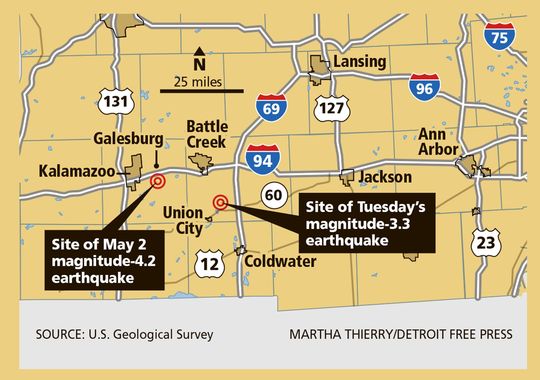Today's temblor was about 20 miles from the location of a magnitude-4.2 quake that occurred 5 miles south of Galesburg on May 2 — the strongest earthquake recorded in Michigan in more than 67 years. The two quakes are far enough apart that today's is likely not an aftershock of the previous quake and is apparently not on the same fault line, said Harley Benz, a seismologist with U.S. Geological Survey (USGS) in Colorado.
"After the May event, I suspected we wouldn't see another event, so I was a bit surprised by this one," he said. "What more surprised me is that they weren't in the same locations."
That also intrigues Eric Hetland, an assistant professor in the Department of Earth and Environmental Sciences at the University of Michigan.
"Given the close proximity in time to the earlier 4.2 (earthquake), and the low levels of seismicity in Michigan, it may be related to that earlier earthquake in some manner," he said.
Today's quake, which occurred about 11:43 a.m., was noted on the USGS website. The survey's Community Internet Intensity Map reported residents feeling the quake as far south as northern Indiana and as far north as Holland. The Calhoun County Sheriff's Office, in a news release, said dispatchers received several calls about the quake, but no damage had been reported.
The epicenter of the quake was the southeast corner of Warner Lake, 3.1 miles underground. The epicenter of the May 4 quake was in Galesburg, 3.4 miles below the surface.
Earthquakes can occur when energy stored up in the Earth's crust is suddenly released. This can happen naturally, when moving plates of the Earth's crust slip past one another, or it can be caused by human activities, including hydraulic fracturing, or "fracking," a form of oil and gas drilling or other deep injection disposal of water and other fluids underground.
The May 2 earthquake exposed a geological fault line in southwest Kalamazoo County only speculated about previously. Kazuya Fujita, a geosciences professor at Michigan State University, said it appears the same fault line was involved in a magnitude-4.6 earthquake in Coldwater in 1947, the last earthquake in the state of such an intensity. But Benz said today's quake is not on that same fault line.
The number of earthquakes has increased dramatically over the last few years in much of the U.S. From 1973 to 2008, there was an average of 21 earthquakes of magnitude 3.0 and larger in the central and eastern U.S., the USGS reported. This rate jumped to an average of 99 earthquakes of that intensity per year from 2009 to 2013, and the rate continues to rise. In 2014 alone, there were 659 magnitude-3.0 and larger earthquakes in the same geographical area, USGS reported.
Comment: Michigan, Texas, Mississippi, California, Idaho and Washington have all been jolted by significant earthquakes this year. Across the entire planet seismic and volcanic activity continues to increase dramatically!
In Oklahoma, the state's Geological Survey agency historically recorded one or two earthquakes of magnitude-3.0 or greater per year, on average, in the state. During 2013, that rate shot up to two earthquakes of that intensity or greater per week. The following year, it reached an average of 21/2 such quakes per day. Oklahoma's state geologist in April declared the suspected source of the increased activity as the underground injection disposal of water associated with oil and gas production.
While industrial activities can't be ruled out as a cause of Michigan's recent earthquakes, Benz said, "these quakes look tectonic," or related to the natural processes of the Earth's crust.
The culprit could even be glacial rebound — land masses pressed down by millions of tons of ice during Michigan's last glacial period about 12,000 years ago beginning to rise, Benz said.
In Southern California, where earthquakes are frequent, fault lines are well-known, and a tremendous amount of study and technology is deployed. But much less of a look has been taken at relatively earthquake-free places, like Michigan, Benz said.
However, if activity like the last two months continues, "we certainly would deploy more resources to take a closer look at what's going on there," he said.
Comment: For further insights into why Earth is 'opening up', read Earth Changes and the Human-Cosmic Connection by Pierre Lescaudron.




like this one; "The culprit could even be glacial rebound — land masses pressed down by millions of tons of ice during Michigan's last glacial period about 12,000 years ago beginning to rise, Benz said."
Another more likely plausible explanation might be that energies from space are being converted in to matter by a plasma based core fueled by energies from Universe/Space. Thus causing material to be displaced by an expansion process which can also be detected by out-gassing, rumbling, humming, tearing, sinkholes, and other displacement phenomena. Sort of like we are having huh?